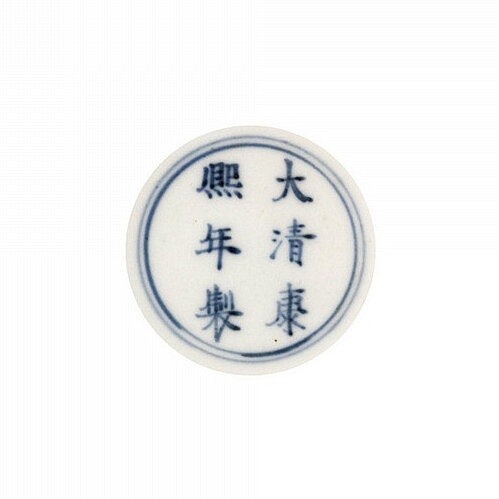A fine doucai 'Three friends' jar, mark and period of Kangxi (1662-1722)
Lot 3160. A fine doucai 'Three Friends' jar, mark and period of Kangxi (1662-1722); 12.3 cm., 4 7/8 in. Estimate 2,500,000 — 3,000,000 HKD. Lot Sold 3,380,000 HKD. Courtesy Sotheby's.
of ovoid form rising to a short neck, painted on the exterior in a continuous scene with the 'Three Friends of Winter' pine, bamboo and prunus, the prunus flowers brightly enamelled in pink and orange shades, the bamboo and pine enamelled in green, all outlined in underglaze blue, the underside inscribed within double circles with a six-character reign mark in underglaze blue.
Note: Kangxi period jars decorated with this charming decoration in the doucai palette are extremely rare. A closely related example from the collections of C. Oswald Liddell, Charles E. Russell, and Paul and Helen Bernat, illustrated in Soame Jenyns, Later Chinese Porcelain. The Ch'ing Dynasty, London, 1951, pl. XLVIII A, and included in the exhibition Bones of Jade, Soul of Ice: The Flowering Plum in Chinese Art, Yale University Art Gallery, New Haven, Connecticut, 1985, cat. no. 73, was last sold in these rooms, 15th November 1988, lot 17. A Yongzheng version of this jar, with a reign mark and of the period, was sold in our London rooms, 25th March 1975, lot 277. Yongzheng blue and white jarlets of this form and subject are more commonly known, for example see one included in the Hong Kong Oriental Society exhibition Chinese Blue and White Porcelain, City Museum and Art Gallery, Hong Kong, 1975, cat. no. 108; and another illustrated in Ma Xigwai (ed.), Beauty of Ceramics. Blue and White Porcelain, Taipei, 1993, pl. 131.
Sotheby's. Fine Chinese Ceramics and Works of Art, Hong Kong, 08 april 2011

/https%3A%2F%2Fprofilepics.canalblog.com%2Fprofilepics%2F1%2F0%2F100183.jpg)
/https%3A%2F%2Fstorage.canalblog.com%2F03%2F02%2F119589%2F96711876_o.jpg)
/https%3A%2F%2Fstorage.canalblog.com%2F11%2F31%2F119589%2F94773502_o.jpg)
/https%3A%2F%2Fstorage.canalblog.com%2F20%2F83%2F119589%2F94772815_o.jpg)
/https%3A%2F%2Fstorage.canalblog.com%2F26%2F72%2F119589%2F75604929_o.jpg)
/https%3A%2F%2Fstorage.canalblog.com%2F59%2F60%2F119589%2F26458628_o.jpg)




/image%2F1371349%2F20240326%2Fob_936d86_104-1.jpg)
/image%2F1371349%2F20240326%2Fob_823710_102-1.jpg)
/image%2F1371349%2F20240326%2Fob_55a293_101-1.jpg)
/http%3A%2F%2Fstorage.canalblog.com%2F33%2F99%2F119589%2F129627838_o.jpg)